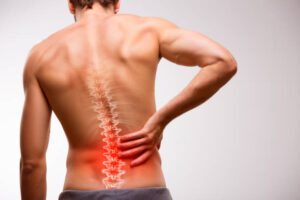Back Pain
How The Back Works

The chine, which connects the cranium to the pelvis, is also called the vertebral column. It consists of 24 parts of block- shaped bone called chines and an fresh 9 fused chines that make up the smallest part of the chine, the sacrum and tailbone.
Each chines of the vertebral column has pooching bony areas for the attachment of muscles that are important for the chine to move. The spinal column protects the spinal cord and its arising jitters that run down utmost of the length of the chine. The chines have two major functions To bear the weight of the body To house the spinal cord or spinal whim-whams roots( cauda equine) within the spinal column
The chine is arranged in three natural angles The neck region or cervical chine, made up of 7 chines where the chines curve forward. The box region or thoracic chine, made up of 12 chines where the vertebral column angles backward, and to which the caricatures attach
The low reverse region or lumbar chine, made up of 5 chines- which angles forward in the same direction as the cervical chine. When these angles are in their normal alignment, the body is in a balanced position. This distributes weight unevenly throughout the chines so one is in a less vulnerable position for strain and injury. There are two major corridor to each backbone Vertebral body- The vertebral body is the frontal portion of the chines. It’s shaped like a cylinder and is lesser in height than the reverse portion. Vertebral bow- The vertebral bow is the reverse portion of the chines. It’s an desultorily shaped structure.
At the center of each backbone is a hole, defended by the girding strong bone. Placed together, the central opening of each backbone makes up the spinal conduit through which the spinal cord, cauda equina, or spinal whim-whams roots pass. The spinal cord is the mass of whim-whams that connect the brain to the rest of the body. Each backbone has important bony protrusions called processes that give spots for the attachment of ligaments and muscles that are important for the stability and movement of the chine.
The protrusions on either side of each backbone are called transverse processes, and the bones
at the reverse are called the spinous processes. The transverse processes are long and slender; the spinous processes are broad and thick. The reverse portion of the chines, behind the transverse processes, consists of an area of bone called the lamellae . On the aft part of the chines are two upper and two lower processes that form the joints connecting the aft part of each backbone. These are the hand joints. They’re important for movement between each backbone and for movements of the entire vertebral column as a unit.
The Discs Of The Back Between each backbone are spongy pads, like soft cocoons, called discs- or further rightly, inter vertebral discs. Each slice has a soft jelly- suchlike centre called the nexus populous, which is girdled by a stringy external envelope called the annulus fibrosis. Eighty percent of the slice is water, which is why it’s so elastic. Together, a slice with the attached part of the backbone over and below is considered an inter vertebral joint. These joints allow the movement of the reverse.
Healthy discs are elastic and springy. They make up 20 to 25 of the total length of the vertebral column. originally, the slice contains about 85 to 90 water, but this quantum decreases to 65 with age, performing in slice degeneration. The Spinal Cord And The Lower Back The jitters that come off the spinal cord are called whim-whams roots. These whim-whams roots pass through small openings on either side of the connecting chines. colourful whim-whams roots combine to form spinal jitters.
There are five dyads of lumbar( lower reverse) spinal jitters. The whim-whams roots that arise from the end of the spinal cord and continue down the spinal conduit through the lower part of the chine looks like a” steed’s tail” and are inclusively named the cauda equina. The Ligaments Of The Back There are a series of ligaments that are important to the stability of the vertebral column. Important to the lumbar chine( lower reverse) are seven types of ligaments Anterior longitudinal ligaments and posterior longitudinal ligaments are associated with each joint between the chines.
The anterior longitudinal ligament runs along the front and external shells of the vertebral bodies. The posterior longitudinal ligaments run within the vertebral conduit along the reverse face of the vertebral bodies. The ligament flagellum is located on the reverse face of the conduit where the spinal cord or caude equina runs. The inter spinous ligament runs from the base of one spinous process( the protrusions at the reverse of each backbone) to another. Inter transverse ligaments and supra spinous ligaments run along the tips of the spinous processes. common-affiliated structures called capsular ligaments also play an important part in stabilisation and movement.
The Muscles Of The Lower Back
The muscles and tendons of the chine have been described as being a supporting system for the chine, much like a roof supported by companion ropes. A group of back muscles called the erector spinae are an illustration of these muscles, which form on each side of the chine and correspond of three columns. These muscles move the lower reverse, help unbend the reverse, give resistance when a person is bending forward at the midriff, and help a person return to the standing position. The multifidus is another important muscle of the lumbar region. This muscle is thick and prominent in the lumbar chine and becomes lower at its attachments grandly up the chine. It’s an effective switch arm that allows the lumbar chine to bend backward.